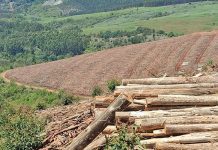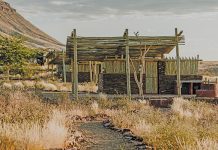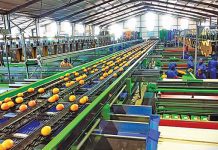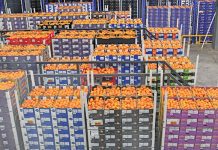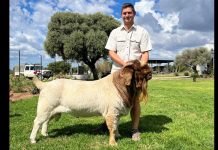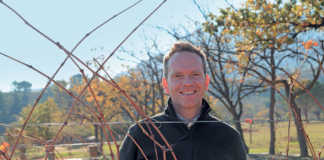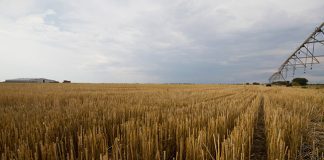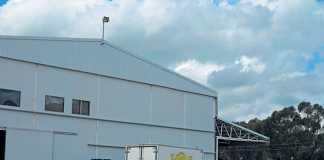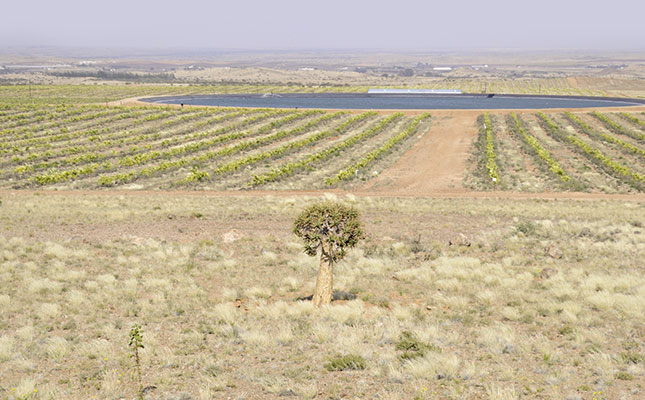
Photo: Jaco Visser
“It’s a huge team effort,” says Dirk Rabie, general manager of the Berekisanang development, as he pulls out weeds among the vines of this R300-million grape and citrus project. Rabie is not exaggerating, and his comment echoes the name of the project, which means “Work together” in Setswana. Berekisanang is 15 minutes’ drive north of Kakamas in the far south of the semi-arid Kalahari region.
READ MORE: Fresh wind blows in the Kalahari for the Khomani San
An empowerment project, it was launched in 2009 with loans from the European Union, the state-owned Industrial Development Corporation (IDC), the Department of Human Settlements, and Afrifresh. When the farm is in full production, it will see the permanent employment of around 600 people, peaking at 1 300 during harvest time, according to Afrifresh’s Adri van Niekerk and project co-ordinator and the driving force behind the operation.
At the start
Van Niekerk began applying for the subdivision of farms in 2009. Berekisanang is the last irrigated farm on the road between Kakamas and Lutzputs, a hamlet close to the Namibian border. Once the programme’s application for water rights was approved, agricultural company Afrifresh, one of the largest exporters of South African fruit, reached out to black workers on Berekisanang’s neighbouring table grape farm, Galactic Deals, to gauge interest in the new project.
“Workers were granted a combined 500ha of water-use rights by government in 2012,” Van Niekerk says. “This was their contribution to the equity of Berekisanang.” Workers with more than 10 years’ service at Galactic Deals joined as trust beneficiaries. Van Niekerk explains there are 24 beneficiaries of the trust who make up the bulk of the trustees.
Two beneficiaries work on Berekisanang. The farm workers’ trust owns a 17,01% share in the trust, thanks to the water-use rights they secured. The IDC owns 22,68%, while Galactic Deals, which is majority-owned by Afrifresh, holds 39,1%. An IDC risk-capital fund, RCF, owns 21,21%. RCF is a structure providing loan funding, and is backed by grants from the EU for the purpose of black economic empowerment.
Once RCF’s loan is repaid, its shares will be transferred to the farm workers’ trust, Van Niekerk explains. This will leave the trust as the second-biggest shareholder, after Galactic Deals. Strict budget targets, set in consultation with the IDC, are in place and, according to Van Niekerk, are being met. The day-to-day running of the farm, which includes the services of an agricultural scientist, is overseen by Afrifresh.
Berekisanang also received a housing grant worth R42 million from the Department of Human Settlements. This will finance the construction of three towns, comprising 397 houses on the farm by 2017. It is planned that by the same year, 200ha of grapes and 200ha of citrus will be planted. The farm covers 1 016ha in total. Van Niekerk says that communication and training of trustees and beneficiaries are key to the operation of the farm.

From left: project co-ordinator Adri van Niekerk, trustee Christa van Rooi and general manager Dirk Rabie.
With the help of outside consultant, AgriExpert, which has experience in empowerment projects, the beneficiaries and trustees receive regular training in their duties. They are also taken to the farm once a month and receive updates of the progress with developing the vineyards and citrus orchards. Berekisanang is not close to a water source and the farm’s irrigation needs are met by a 3,2km pipeline from the valley’s Noordvoor (Northern Canal).
This was dug by impoverished white farmers who were hit by the rinderpest of the 1890s and were settled in Kakamas by the Dutch Reformed Church. The water is pumped through an 800mm diameter pipe to an on-farm dam with a capacity of 113 000m³. It is the largest dam lined with plastic in the Northern Cape, Rabie says. The vines and citrus trees are watered via micro-irrigation. Regular soil analyses are conducted and fertigation is also applied. The choice of cultivars planted was taken solely on the marketability of the grapes and citrus, Rabie explains.
Grapes
The vines were planted in August last year and the first harvest is expected in November and December. It is expected to deliver 80 000 cartons of 4,5kg each off 50ha. All vineyards are planted under net to protect them from hail storms and to limit early spring frost damage. Cultivars include white seedless varieties Prime (25ha to be planted in 2015), Early Sweet (55ha), Sugra One (17,5ha) and Sugra 12 (21ha). Red seedless varieties, to be planted on 56,5ha in 2015, will consist of Timco, Magenta, Evans Delight and Tawn. One black seedless variety, Melody, will be planted on 25ha.
READ MORE: Innovation drives top young table grape farmer
High summer temperatures allow for farmers in the Lower Orange River Valley, which extends from Upington downriver, to export table grapes earlier, and receive a premium for their fruit. The Hex River Valley and the Boland, both table grape regions, come into production after the Orange River region.
Citrus
The harvesting of citrus commences in late April and concludes in late July. All citrus trees have already been established. They include 65ha lemon, 85ha pomelos and 50ha oranges. The first harvest of 50 000 cartons of 15kg is expected in 2017.
Rabie says that the excessive heat for which Kakamas is known, where temperatures can exceed 50°C in summer, is not a concern as the orchards will create their own microclimates once the trees are fully grown. The combination of grapes and citrus solves the traditional problem of seasonality experienced by grape farms along the Orange River.
Modest beginnings
The Dutch Reformed Church appealed successfully to the Cape Parliament in the late 1890s to set up a labour colony for impoverished farmers on the farm Neus. Those intending to settle in the colony, where the use of money was forbidden, had to deliver a letter of good standing from their church minister.
Settlers dug two canals, on the northern and southern bank of the Orange River, to provide the newly laid-out plots with water. Japie Lutz, a self-taught engineer, planned the canals’ routes, which included digging through a kopje. To irrigate the plots, farmers built water wheels, utilising the energy of flow to pump water. The canals are still used as the primary irrigation source today, after being upgraded in the late 1980s.
This article was originally published in the 15 August 2014 issue of Farmer’s Weekly.



